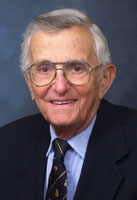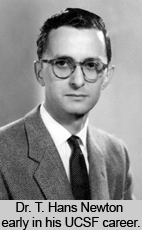T. Hans Newton Memorial Lecture
 The annual T. Hans Newton memorial lecture is held each October in memory of the life and work of esteemed Professor Emeritus T. Hans Newton, MD, whose career in the Department of Radiology and Biomedical Imaging spanned five decades.
The annual T. Hans Newton memorial lecture is held each October in memory of the life and work of esteemed Professor Emeritus T. Hans Newton, MD, whose career in the Department of Radiology and Biomedical Imaging spanned five decades.
Past T. Hans Newton Honorary Lecturers
- 2024: Jody Tanabe, MD – ‘Functional MRI of Psychiatric Disorders’
- 2023: David J. Mikulis, BSc, MD, FRCPC – 'The Brain Stress Test'
- 2022: Linda Gray Leithe, MD – 'Adventures in Primary Care Neuroradiology: 20 years of Spinal Interventions in the Treatment of Pain, Headache, and CSF Pressure Disorders'
- 2021: Tina Young Poussaint, MD, FACR – 'Pediatric Brain Tumor Imaging in the Molecular Era'
- 2019: Achala Vagal, MD, MS – 'Acute Stroke Imaging: Current Evidence, What is Unknown, and What is Next'
- 2018: Charles Limb, MD – ‘Neural Substrates of Musical Creativity’
- 2017: R. Nick Bryan, MD, PhD – ‘The Future Role of Humans and Computers in Medical Diagnosis’
- 2016: Pamela Whitney Schaefer, MD – ‘Acute Stroke Imaging: Algorithm for Diagnosis, Triage, and Outcome Prediction’
- 2015: Jeffrey Jarvik, MD, MPH – ‘Pramatic Clinical Trials, the NIH Collaboratory and Lumbar Spine Imaging: Dragging the RCT to Routine Practice’
- 2014: Whitney Pope, MD, PhD – ‘Important Molecular Variants on GBM: Impact on Imaging’
- 2013: Joshua Shimony, MD, PhD – ‘Resting State fMRI: New Clinical Applications’
- 2012: Joseph A. Maldjian, MD – ‘Clinical Applications of Arterial Spin-Label MRI’
- 2011: Charles Raybaud, MD, FRCPC – ‘Corpus Callosum and Other Great Cerebral Commissures: Development and Malformations’
- 2010: Michael Brant-Zawadzki, MD, FACR – ‘Diagnostic Radiation and Carcinogenesis: What Do We Know?’
- 2009: Caroline D. Robson, MB, ChB – Imaging of Pediatric Hearing Loss: Correlating Genotype with Phenotype’
- 2008: Eugene J. Carragee, MD – ‘Diagnostic Injections in Spinal Disorder’
- 2007: Jeffrey R. Petrella, MD – ‘Functional MRI: Current and Future Clinical Applications’
- 2006: Ramón Gilberto González, MD, PhD – ‘Acute Ischemic Stroke: Imaging Physiology and Guiding Therapy’
- 2005: Robert M. Quencer, MD – ‘Spinal Cord Injury: ‘Clinical/Imaging/Surgical Considerations and a Look to the Future’
- 2004: Robert I. Grossman, MD – ‘A Radiologist’s Perspective on Multiple Sclerosis’
- 2003: Colin P. Derdyn, MD - ‘The Role of Hemodynamic Factors in Ischemic Stroke’
- 2002: Patrick A. Turski, MD - ‘Subarachnoid Hemmorage’
About T. Hans Newton
 Dr. Thomas Hans Newton was born May 9, 1925 in Berlin, Germany. His immediate family escaped prior to World War II, starting a new life initially in Portland, Oregon. Hans enrolled in grade school speaking no English at the age of 11. His undergraduate years at the University of California, Berkeley were interrupted by military service in the Navy, but he graduated with a Bachelor of Arts in 1949, matriculating to UCSF where he received his MD degree in 1952. After a year of internship at the University of Wisconsin and a year as a UCSF medicine resident, Hans completed his residency in radiology at the Peter Bent Brigham Hospital under Merrill Sosman. As was common at that time, Dr. Newton then spent one and a half years as a fellow in Stockholm, Zurich, and London, where he trained in neuroradiology at the National Hospital for nervous diseases, Queens Square. In 1959, he joined UCSF, and remained on the faculty for 50 distinguished years. Hans passed away on June 6, 2010.
Dr. Thomas Hans Newton was born May 9, 1925 in Berlin, Germany. His immediate family escaped prior to World War II, starting a new life initially in Portland, Oregon. Hans enrolled in grade school speaking no English at the age of 11. His undergraduate years at the University of California, Berkeley were interrupted by military service in the Navy, but he graduated with a Bachelor of Arts in 1949, matriculating to UCSF where he received his MD degree in 1952. After a year of internship at the University of Wisconsin and a year as a UCSF medicine resident, Hans completed his residency in radiology at the Peter Bent Brigham Hospital under Merrill Sosman. As was common at that time, Dr. Newton then spent one and a half years as a fellow in Stockholm, Zurich, and London, where he trained in neuroradiology at the National Hospital for nervous diseases, Queens Square. In 1959, he joined UCSF, and remained on the faculty for 50 distinguished years. Hans passed away on June 6, 2010.
Dr. Newton’s academic accomplishments and awards were myriad. He founded the section of neuroradiology at UCSF, and trained over 160 fellows over a span of 40 years. His multi-volume text “Radiology of the Skull and Brain”, otherwise known as “Newton and Potts” was the “red-bible” of neuroradiology for decades. With the advent of CT and MR, he continued his contributions with “Modern Neuroradiology”, a four-volume text still considered a standard. He was one of 14 founding members and was a president of the American Society of Neuroradiology, and received its first gold medal. He was an honorary member of the European Society of Neuroradiology, past-president of the Western Neuroradiologic Society, and served on the editorial boards of most of the leading journals in radiology.
Among his accomplishments were the introduction of the Seldinger technique for cerebrovascular angiography in the United States, the first embolization of a spinal arteriovenous malformation, and the introduction of computed tomography and MR imaging at UCSF. He was a superb angiographer with meticulous attention to detail and a quick eye. As Dr. Newton’s reputation, and that of UCSF, spread throughout the world, UCSF became a center for training academic radiologists from around the globe. Among his contributions were seminal articles on “Arteriography of cerebrovascular occlusive disease” in the New England Journal of Medicine in 1962, descriptions of arteriovenous malformations and fistula of the posterior fossa in 1966 and 1968, and a classic article entitled “Involvement of the dural arteries in intracranial arteriovenous malformations” published with Sven Cronquist in 1969.
Hans’ love of travel and his penchant for discovery of different cultures took him to the far reaches of the globe with his life-long companion and spouse, Pat Newton. He hiked through the mountains of Nepal reaching Everest base camp, boated through the Amazon rainforest, climbed Mt. Kenya, and through his mid-sixties could beat all the fellows in the two mile race around the base of Mt. Tamalpais prior to the frequent barbeques at the Newton home in Kentfield. He was most proud of his daughters, Judy, an attorney and Diane, a neuroradiologist, as well as five wonderful grandchildren and his great-grandson.
It is with great pride that the Department of Radiology and Biomedical Imaging honors Dr. Newton each October with the annual Newton Lecture.
